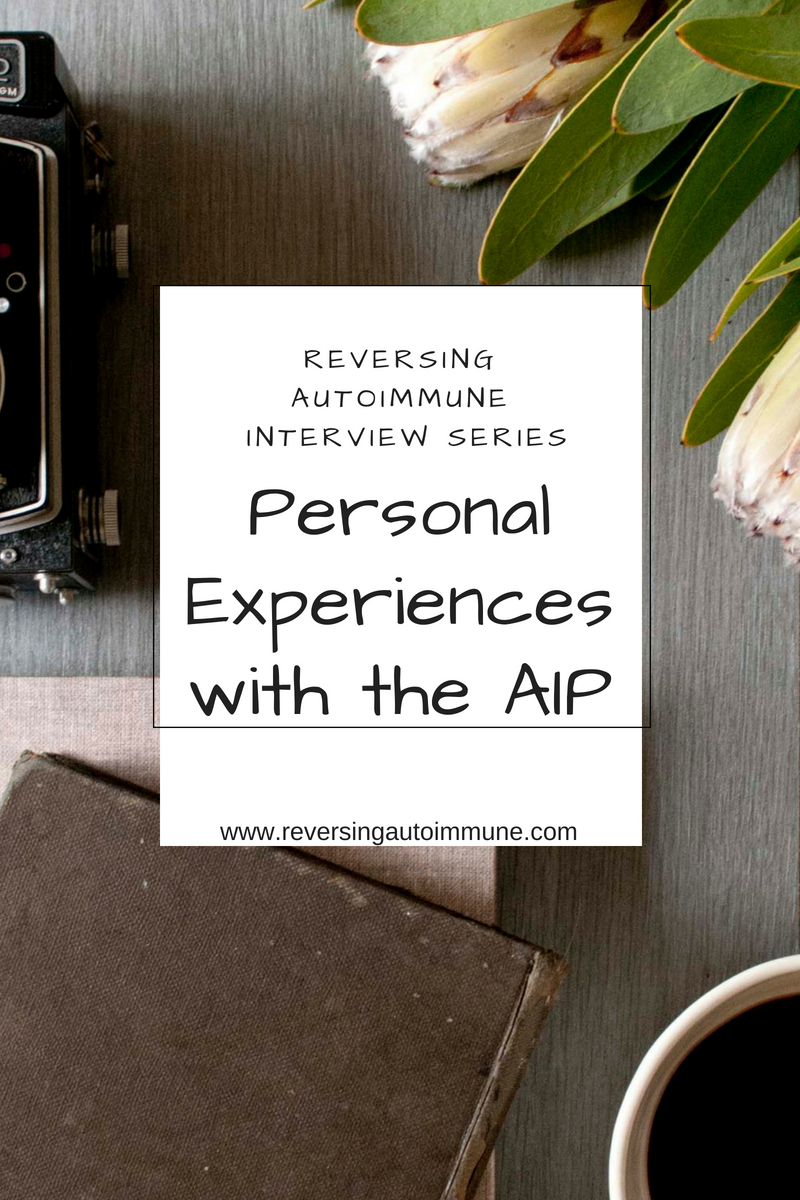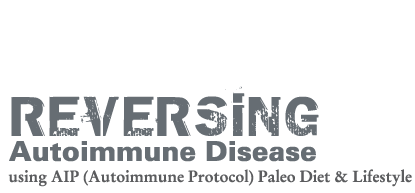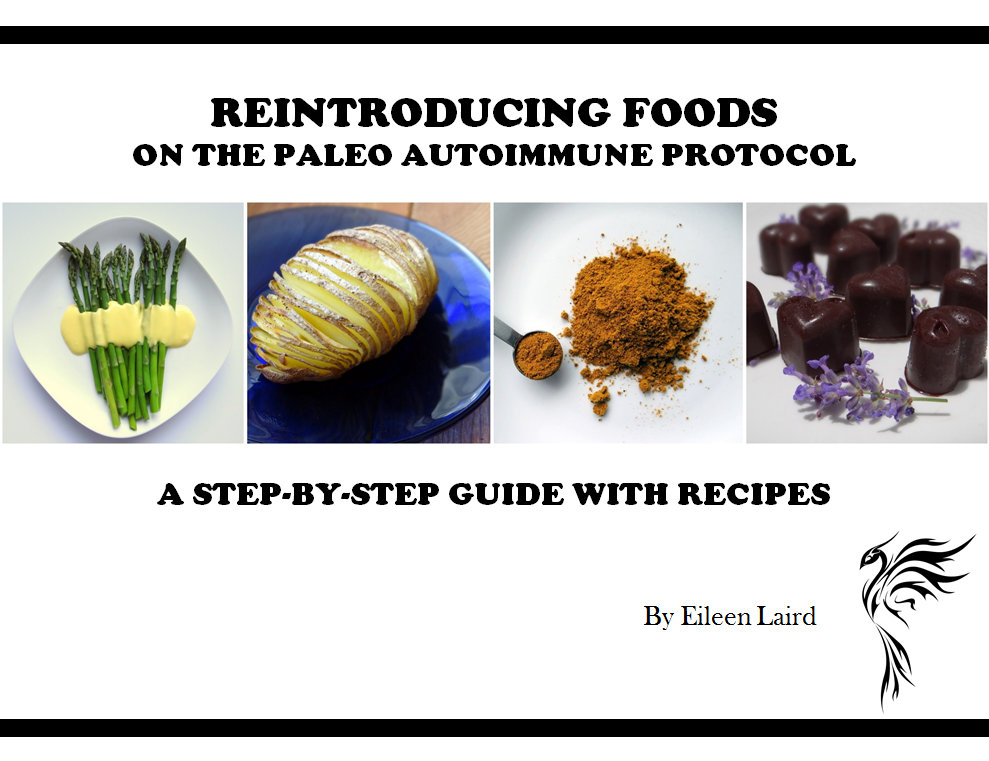Reversing Autoimmune AIP Interview Series -Tina

The Autoimmune Protocol (AIP) has helped so many people to reverse their autoimmune symptoms and for many people reverse the disease completely. It is however, not a one size fits all approach, and as we learn more and more about autoimmune diseases, we have started to discover that a more individual approach may be better. Unfortunately, at this stage, an elimination phase of removing all the main inflammatory foods and then slowly reintroducing them one at a time, is still the gold standard to work what individual triggers affect each person. (read more about the science behind the AIP and more about reintroducing foods)
Each person has their own unique experiences of AIP, regarding what foods they can and cannot tolerate and what lifestyle factors they have included. In this interview series, I ask different people about their own personal experience with AIP.
The things that are unique to all of us is how long the elimination lasted, what foods we react to and what foods we do not. The other vital factor is finding ways to reduce stress, incorporate exercise, work on relationships and deal with emotional issues are also vital aspects that mustn’t be overlooked. If you are someone considering trying AIP and are unsure, I hope that these interviews may help to show that no matter the name of your disease, or what foods you react to, everyone needs to find their own way of making AIP work for them and that it is possible to do that in whatever way works for you.
Tina’s Personal Experience with the AIP
Tina has a particular interest in autoimmunity and allergies. If you would like to connect with her you can follow her on Instagram or email her at autoimmunityandallergies at hotmail dot com

My notes are in brackets.
1.What Autoimmune Disease/s do you have?
2.When did you start doing the AIP and what motivated you to do it?
During grad school, my symptoms had peaked. I was so frustrated with them that I decided I would take action and take control of my thyroid condition. So one night, I stayed up browsing my school’s science journal database for articles on Hashimoto’s and bought two life-changing Hashimoto’s books on Amazon. ( This one and this one :)) I was introduced to the concepts of intestinal permeability as a root cause of autoimmune disease, as well as removing gluten as one of the solutions to resolve “leaky gut syndrome”. While googling gluten free/Hashimoto’s success stories, I stumbled across the AIP and Paleo communities. After reading material and studies on the “what”, “how” and “whys” of AIP, I decided to try it in hopes it would reduce inflammation and symptoms. ( for more on AIP support groups around the world)
3.What symptoms did you experience before going on AIP?
There were so many! I had acid reflux which were sometimes felt as heart palpitations when I’d lie down, plus RLS, resulting in insomniac nights throughout university. I also had low ferritin levels, which made my face and lips look pale, as well as an intolerance to cold temperatures -I’d wear long sleeves in the summer-, migraines, headaches, and “soft” spots on my nails. During thyroid flare ups, I would experience periods of social anxiety, as well as hair loss and weight fluctuations. My ring size fluctuated a lot throughout the day! The toughest symptom, however, was gaining food sensitivities and allergies over the course of a few months. (for more on Hashimoto’s)
4.What symptoms went away after going on AIP?
After going on the AIP, the heartburn/acid reflux, insomnia, RLS, headaches, migraines, and hair loss disappeared. My hairdresser noticed my thicker, fuller hair right away!
5.What (if any) symptoms still remain?
In terms of thyroid-related symptoms, none! 🙂 I am so grateful that implementing dietary interventions and addressing my root cause triggers like leaky gut, parasites/co-occurring infections, toxins, Candida, nutrient deficiencies have played a huge role in helping me restore my health.
Of course, we are constantly exposed to toxins and parasites in the air and our food, but I’ve found that addressing them as soon as they are noticed makes recovery from them quicker and stops old symptoms before they can show up.
I am working on overcoming my allergies, which I’ve had since I was a child, so they are not necessarily Hashimoto’s-related.
6. How long did you do the Elimination Phase of the AIP?
I waited at least 6 months after starting the AIP before reintroducing anything. During the first year of reintroductions, before addressing all my underlying root causes, the elimination phase was a hit or miss with many foods. ( for more help with reintroducing foods on the AIP)
The intestinal permeability I once had is gone, as is my liver toxicity, so I can try reintroducing more foods now. However, I’ve been told that the half-life periods for food antibodies can range from 6 months to 2 years, so I have yet to reintroduce all of them back. Part of me wants to wait the full 2 years to ensure all the antibodies are gone.
7.Which foods did you find you react to or made your disease worse?
Gluten was the biggest one. Some foods that are common food sensitivities in those with Hashimoto’s, like egg whites, soy, corn, and nuts also caused reactions. Other surprising IgG reactions were caused by certain nightshades and legumes like sweet bell peppers, green beans, snow peas, and red kidney beans. ( for more on what foods are removed during the elimination phase)
As a side note, I realized that I had a nickel allergy, so removing foods high in nickel -which are often AIP “no” foods- resulted in no more dry skin reactions after being in contact with nickel!
8.Are there any foods that are AIP compliant that you cannot tolerate or foods that aren’t that you can?
Right after starting the AIP, I had reactions to coconut, kale, cauliflower, and sweet potato. I also experienced IgE-mediated reactions to cassava/tapioca, banana, and avocado due to the fact that their proteins can cross-react with latex. This made following the AIP really hard, because those are probably the 7 most common ingredients in AIP-compliant recipes -especially ones for pseudo flours- I also realized I was sensitive to certain FODMAPs like ginger, garlic, and onions. ( For more on IBS/SIBO check out the free summit starting September 3rd)
That said, everyone’s genetic makeup is different – we all have our personal food sensitivities, and I’m thankful that I can eat potatoes, black beans, and rice. The latter is a staple food in my culture – and, when sprouted, can be a great source of magnesium and other essential nutrients. 🙂 I can also eat sweet potatoes again, which makes meal planning so much easier. Now I can bring sweet potato chips on road trips!
9.What lifestyle modifications did you introduce? Did that make any difference to how you feel?
My lifestyle completely changed, and for the better. I buy organic/non-GMO foods whenever I can. I drink lemon water to support my liver. I’ve also removed toxic chemicals from the home. All my personal care products and cookware are made of natural materials and do not leach heavy metals either. The biggest changes were actually switching to natural, fragrance free hand soap and fluoride free toothpaste. After doing so, I immediately noticed a change in my energy levels – I felt 16 again! 😉 And of course, I now approach life with a positive attitude. I think one’s outlook on life and receptiveness to positive changes really does make a difference in one’s healing journey… ( for more on lifestyle aspects of the AIP)
10. Did you take any medication before you began AIP and do you take any now?
When I was diagnosed with Hashimoto’s, I was started on thyroid hormone replacement medication (synthetic T4), and I’m currently still taking it.
I’d also occasionally take acetaminophen or ibuprofen for headaches and cramps, but I don’t anymore! For the occasional cramps, I use natural and herbal remedies now. (for my story on my decisions regarding medication)
11. Do you do any exercise, is it any different to what you did before?
I’ve never been a huge exercise junkie, partly due to the fact I had an injury when I was younger, and another condition that is unrelated to autoimmune disease. That said, I now exercise a lot more than I used to because I know that being active plays a part in maintaining one’s health. Plus, I try to do sweaty activities -like dancing… at home, when no one’s watching- every once in a while to help support my liver detoxification pathways. 🙂
12.What was the easiest part of doing the AIP?
Honestly, the easiest part was removing gluten from my life. It’s often the most difficult part of doing the AIP, but I just shifted my mindset. I told myself it would be worth it because my only goal was to put my symptoms into remission. Plus, I had found gluten free versions of most of my favourite foods, so I knew I wasn’t going to miss them!
The second easiest part was saying “no” to GMO foods and inflammatory processed foods. After you see the greener side -whole, healing foods-, the other side ceases to be appealing.
13.What was the hardest part of doing the AIP?
Without a doubt, the hardest part was not being able to participate in so many events and outings with friends and family. I could no longer enjoy the restaurants we used to go to. Family dinners were spent watching everyone else eat. It is the elders that decide where to eat, and they are accustomed to non-GF/AIP-friendly cuisines from their cultures.
It was equally tough to “celebrate” personal special occasions. Due to my sensitivities to the most common ingredients in AIP-compliant cakes, I wasn’t able to have cake for birthdays or even my wedding! I think the hardest part was dealing with people exclaiming, “What! You can’t have a wedding without cake!”, without understanding my circumstances. But, I’ve learned to not care what others think of my decisions, and I always try to make the best of every challenge.
14. Were your family/spouse/friends supportive of your decisions; if not, did they change their minds afterwards?
While the majority of my relatives still do not quite understand the reasonings behind my decisions and still ask me, “Why not have just a little bit of gluten?”, I’m happy to say that my parents were so supportive of my Hashimoto’s health journey from the start. My spouse -my fiancé at the time –was also supportive. He is now gluten free as well, in the name of solidarity -and no cross-contamination in our home.
As for my friends, I did notice that many of them stopped inviting me to dinners as accommodating gluten free requests and a long list of food sensitivities left a very few number of restaurant options. But, this revealed who my real friends were – the ones that didn’t mind just drinking water in a cafe or doing something completely non-food related.
-Side note: I am grateful to now have friends with Hashimoto’s around the world – including some in South Africa 😉 – with whom to share nothing but mutual support! <3 ( I am grateful to have you as a friend and for sharing your experiences on my blog :))
15.If you had to start the AIP all over again, would you do anything differently?
If I could go back in time to when I was just starting the AIP, I would look into the concept of oral tolerance and consider re-introducing some foods back into my diet sooner.
16. Would you recommend it to someone else with autoimmune disease?
Absolutely. You have nothing to lose except possibly a few foods that you’re sensitive to. 😉 However, I would remind anyone considering the AIP diet that the AIP is meant to be used as a guideline and can be modified to one’s individual needs. They may be sensitive to some foods that are permitted on the AIP diet, so trying an advanced elimination diet, taking a food sensitivity test, and looking into possible underlying issues like parasitic infections or SIBO that could be at play behind some food sensitivities might be something to consider if they continue to experience symptoms despite following the AIP.
Tina has a particular interest in autoimmunity and allergies. If you would like to connect with her you can follow her on Instagram or email her at autoimmunityandallergies@hotmail.com
*
This is part of a Series of Interviews, see here for :





